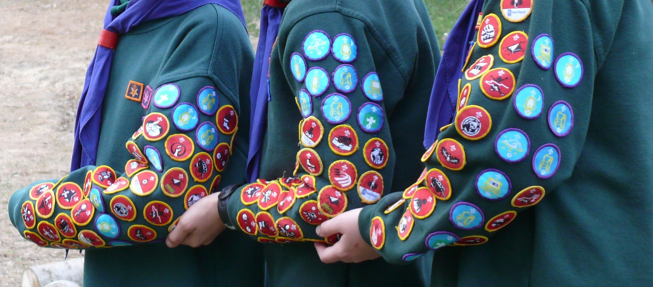How long are your sleeves – Open Badges
I always take an interest in new learning technologies and how they may best fit our own institutional needs here at The University of Edinburgh. So on 25th April 2013 I attended a JISC RSC event in Glasgow on Open Badges, their design and application.
The full day session was led by Doug Belshaw from the Mozilla Foundation and Tim Riches from DigitalMe, with facilitation from Grainne Hamilton from the JISC RSC Scotland.
The session as a whole was good fun, the speakers were engaging and knowledgeable, and the sessions were highly interactive.
We were encouraged to think about the potential uses of badges, with the more obvious ones being perhaps their use alongside LinkedIn endorsements, code academy contributions, or as supplements to the student HEAR. I appreciated the ‘closer to home’ suggestions that were made, as these might be easier to trial. These included badges for teamwork, or for an organization’s social responsibility, or perhaps for excellent customer service or for presenting at a conference/event. Such a pilot might also help identify appropriate tools to support the display of badges, e.g. the ePortfolio system, PebblePad? Or something more public?
The case for badges in preference to certificates seems clear to me at least in that they are more open and versatile than a certificate that often gathers dust in a draw. The ability to re-surface what is effectively an image with associated meta-data on a website seems a nice simple solution. Meta data is not necessarily complex, as it comprises name, description, criteria, issuer, evidence, date standard and tags. The security of the encrypted backpack provided by Mozilla for storing badges also seems to me to be less prone to loss or damage than a paper certificate, and is more portable as the badges can be associated with multiple email addresses and kept as evidence of Life Long Learning.
Our hosts were clear in their view that badges can augment traditional educational or training practice rather than aiming to usurp it.
So how valuable might badges be to their recipient. Well this seems to depend on a few notable factors:
- The reputation of the issuer
- The rigor of criteria and evidence for attainment
- The care in which the badge ecosystem and pathways are developed by the issuer
It seemed to me that badges could be issued and earned by almost anyone with the basic know-how, so that their growth could be equally grass roots initiated and even viral. The cool design of some badges we were shown lends itself to that skateboarder type of branding. My worry with this is that like any plant that grows too quickly without support, it tends to be short-lived. A fad. This might be a missed opportunity, as if planned with sustainability in mind, the badges may provide useful visible pathways to meaningful achievement.
Further relevance to current teaching and learning may be argued in the potential for badges to enhance our thinking in terms of self and peer assessment. Some badges might be automatically earned through a process of evidenced self-reflection and corresponding action. Badges might be awarded by a recipient of excellent feedback, in recognition of the critical thought that had been applied on their behalf. Badges might also indicate who would be an appropriate person from whom to seek advice.
Having completed the day and in the process learned how to map out a badge using a ‘planning canvas’ and earned a badge for my attendance, I was left with my own reflections on whether and how my team, Information Services or Edinburgh University should engage with this phenomena. My feeling is that consultation with potential recipients is required to better understand what team members or students would ‘really’ value. A small interest group should think about piloting badges in a contained area. Information and knowledge should be shared with potential stakeholders, for example those providing MOOC’s. Certainly we should be conscious of the culture of our younger learners coming through a system framed by the Curriculum for Excellence, where the appeal of badges may be stronger.
Some references:





